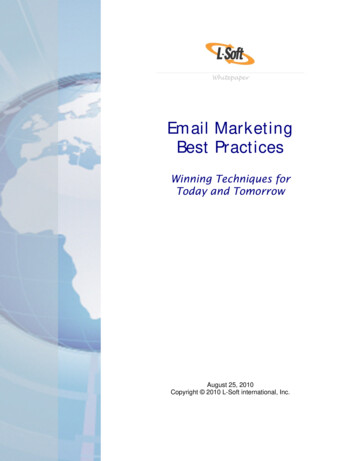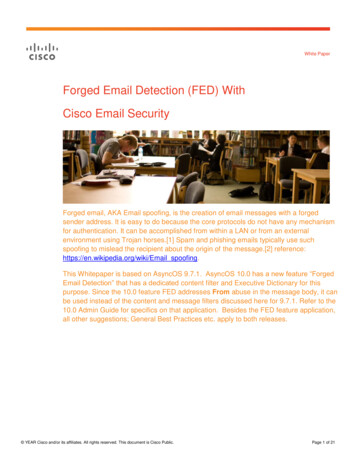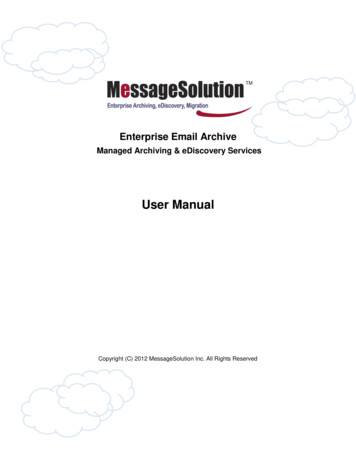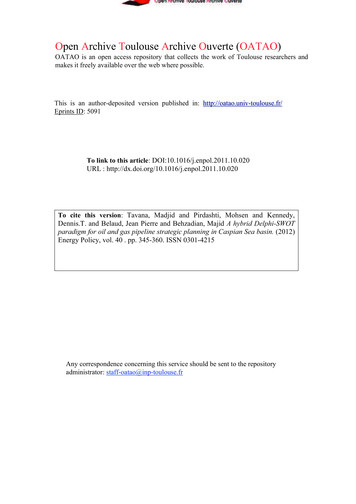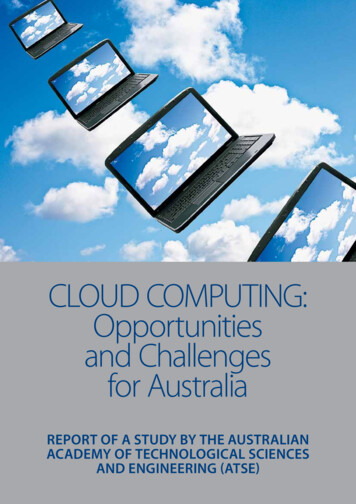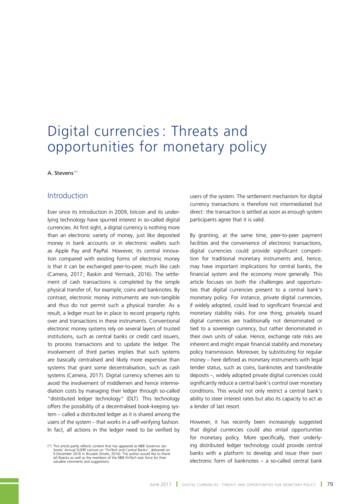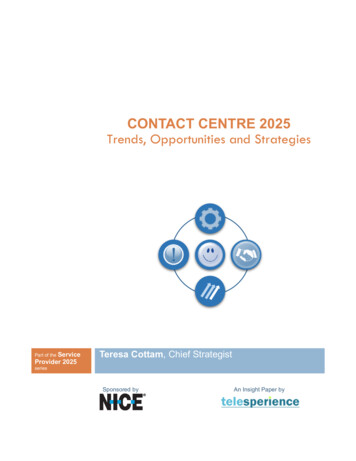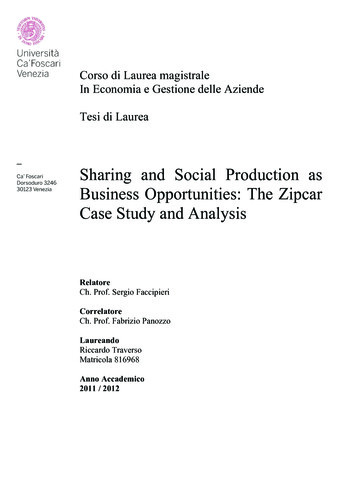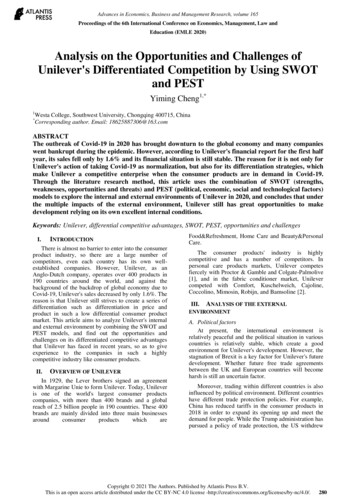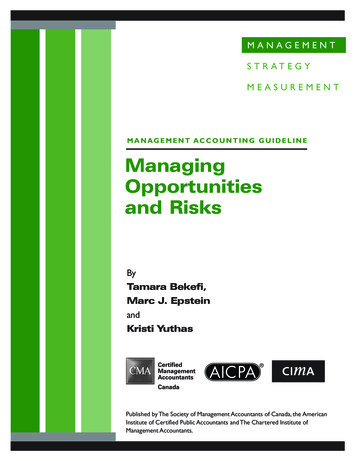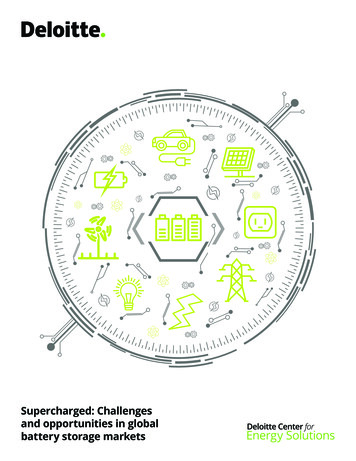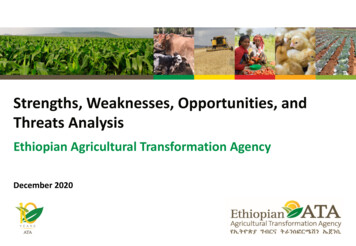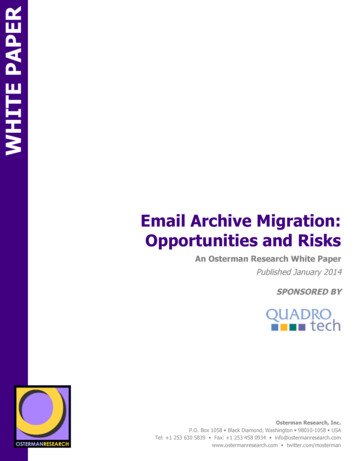
Transcription
WHITE PAPEREmail Archive Migration:Opportunities and RisksONAn Osterman Research White PaperPublished January 2014SPONSORED BYSPONsponsored bysponsored byOsterman Research, Inc.P.O. Box 1058 Black Diamond, Washington 98010-1058 USATel: 1 253 630 5839 Fax: 1 253 458 0934 info@ostermanresearch.comwww.ostermanresearch.com twitter.com/mosterman
Email Archive Migration:Opportunities and RisksEXECUTIVE SUMMARYEmail archives are an essential tool for managing business information. Althoughmany organizations store important business information on backups or in .PST files,the best practice for long-term, secure storage of critical information assets is in anemail archiving system.Because email archives index content, store it (ideally) in an unalterable format onreliable media, and allow it be searched using robust search tools, strategicinformation assets that must be retained for many years are most secure whenretained in an email archiving system.THE NEED TO MIGRATE ARCHIVESAlthough the content in email archives must typically be retained for many years –and sometimes indefinitely – there are a variety of issues and problems that occurwith some frequency that necessitate the migration of email archives from oneplatform to another. For example: Many organizations are migrating to new messaging platforms, such as MicrosoftExchange 2013, which typically necessitates migration to a new archivingsolution. Modernization of core email infrastructures is creating significant flux in thearchiving market as even very large enterprises migrate some or all of their usersto cloud-based email solutions, such as Office 365. The adoption of the cloud,and particularly the growth of hybrid on-premises/cloud-based architectures, willnecessitate archive migration. The more robust capability for long-term information retention in Exchange 2013creates the opportunity for revised email archiving strategies. The acquisition of one company by another or the creation of a new division intoa separate operation will often require an archive migration. The former willtypically require the consolidation of two archiving systems into one, while thelatter will require the deployment of a new archive and migration of data into it. The consolidation of multiple archives into a single archive, for example when acompany migrated to a new archiving solution several years before, butmaintains a legacy archive for older data. Reimplementing an archiving system with a completely redesigned architectureor when moving to a new storage technology. Other events, such as migrating user archives between sites or when moving toa new desktop infrastructure.Migratingarchives is not atrivialundertaking.Migrating archives is not a trivial undertaking. The migration process itself is fraughtwith risk of losing data, corrupting existing information, losing chain-of-custody forinformation, and interrupting user access to archives during the migration. An archivemigration handled improperly can create significant damage to an organization, andso must be a priority for any organization that maintains an email archive.ABOUT THIS WHITE PAPERThis white paper discusses the several important issues associated with drivers forarchive migration and the importance of managing these migrations properly. Thispaper also provides a brief overview of QUADROtech, the sponsor of this paper, andthe company’s relevant offerings. 2013-14 Osterman Research, Inc.1
Email Archive Migration:Opportunities and RisksONGOING FLUX IN THE IT INFRASTRUCTURECHANGES IN THE MIX OF MESSAGING PLATFORMS IN USEThere is an ongoing change in messaging platforms – a key factor in the decision tomigrate to new archiving solutions. For example, since April 1996 Microsoft hasintroduced a new point version of Exchange, on average, every 10 months and amajor new version every 29 months.Because Microsoft Exchange dominates the market for business email, as shown inFigure 1, and because Symantec Enterprise Vault is the leading email archivingsolution in use, a large number of organizations are dealing simultaneously with theimpact of Microsoft’s changes in desktop operating systems, messaging platform andcloud offerings in the context of their current deployment of Enterprise Vault.Anytime there is an introduction of a new messaging platform, such as Exchange2013, there will be significant flux in the market as organizations assess the benefitsof the new platform and decide how and when they should migrate. Microsoft hasadded additional angst for many decision makers with Office 365, a cloud-basedoffering that includes hosted Exchange, SharePoint, Lync, Office and otherapplications that traditionally have been served by on-premises infrastructure. Asnoted in Figure 1, growth in the adoption of Office 365 is expected to be significantby the end of 2014. This is part of a larger trend toward migrating key applications tothe cloud, even for large enterprises that previously would have traditionallymanaged all of their critical business applications on-premises.Anytime there isan introductionof a newmessagingplatform, such asExchange 2013,there will besignificant fluxin the market.Figure 1Distribution of Users by Messaging PlatformQ4/2013 and Q4/2014By the end of 2014 the number of organizations adopting Exchange 2013 is expectedto increase by more than 300%. The introduction of a major new upgrade of amessaging platform will introduce a significant change in the mix of messagingsystems in use as organizations migrate to the new platform. As noted, growth in theadoption of Office 365 is expected to be substantial by the end of 2014,demonstrating the willingness of organizations to adopt cloud technology. As thebenefits of email archiving in the cloud, for example with Mimecast or Symantec’s 2013-14 Osterman Research, Inc.2
Email Archive Migration:Opportunities and RisksEnterprise Vault.cloud, becomes more widely realized it will be important to addressmigration, which will be a major barrier to adoption.Although archiving is primarily beneficial for maintaining information assets forpurposes of eDiscovery, regulatory compliance, storage management and retention ofcorporate knowledge, one of its chief ancillary benefits is the ability to helporganizations migrate to new systems with little interruption. For example, anorganization that migrates to a new messaging platform can more easily populate itfrom a well-managed archiving solution than they can without an archiving solution inplace.ROBUST ARCHIVE MANAGEMENT IS CRITICALMultiple Osterman Research surveys of end users have found that the typicalcorporate email user employs his or her email system for approximately 150 minutesper day. This includes sending or receiving email messages, searching for contentstored in the email system, managing contacts, managing tasks, etc. Add to this thefact that email continues to be the primary file transport system in most organizationsand is used to send and receive important business documents like purchase orders,contracts, proposals and the like. Because many users store content within emailinstead of on file shares or in SharePoint, email is a key repository of critical businesscontent. Consequently, email is the most important single source of business contentin most organizations, and so good archive management is essential.EMAIL ARCHIVING SOLUTIONS ARE INCREASING IN USEEmail archives are a critical source of corporate business information. For example,Osterman Research forecasts that the North American installed base of archivingusers will increase from 82.9 million in 2012 to 128.1 million by 2015, representing anaverage annual growth rate of 15.6%i.Email archivinghas become abest practice atthe majority ofmid-sized andlarge organizationsworldwide.Although many organizations do not archive email, email archiving has become a bestpractice at the majority of mid-sized and large organizations worldwide. Emailcontains the primary record of communications and collaboration for mostorganizations, and so archiving this rich source of content is essential for compliancewith regulatory obligations, legal requirements, data mining and other purposes.Email archiving is also an important tool in helping organizations to manage theiremail storage more effectively by moving older and less frequently accessed contentto archival storage.The importance of email archives for both the long-term storage of critical businessinformation and user access to this information should not be underestimated. Forexample, our research found that nearly four in five organizations that has deployedan email archiving system considers it to be either “important” or “mission critical”, asshown in the following figure.Further corroborating the critical importance of ready access to email archives isFigure 2 that shows that an inability to access email archives for just one businessday would be largely or completely unacceptable to more than two in fiveorganizations. Even a relatively short outage – one that lasted only 60 minutes –would be intolerable to 12% of those surveyed.Our research also found that while 63% of organizations with an email archivesystem in place maintain only a single archive, 37% have multiple archives. Amongthis latter population, 39% plan to consolidate their multiple email archives into asingle repository. 2013-14 Osterman Research, Inc.3
Email Archive Migration:Opportunities and RisksFigure 2Importance of the Corporate Email Archiving SystemFigure 3Tolerance of Email Archive Downtime of Various Lengths% Responding Largely or Completely Unacceptable 2013-14 Osterman Research, Inc.4
Email Archive Migration:Opportunities and RisksPLANS FOR ARCHIVING MIGRATIONIn a major Osterman Research survey of the archiving market, one in tenrespondents planned on retaining their current archive in a frozen state, allowing nochanges to the system or its currently archived data, as shown in Figure 4. Thisapproach eliminates the cost and complexity of data migration, but does requireongoing licensing. It can also result in other significant challenges downstream, suchas an inability to get support for the frozen system, the need under an eDiscoveryrequest to search across multiple systems, and the challenges of maintaining legalholds across multiple disparate repositories.More than one-third of those surveyed, the largest group, have not yet decided whichapproach to take. Unfortunately there is no silver bullet, and as noted above, bothapproaches come with pros and cons.Figure 4Plans for Currently Archived Email/Other Content if Planning to Use a NewArchiving Vendor or ProviderAmongorganizationsthat are planninga change to anew archivingvendor orprovider, themajority plan onmigrating theirarchived datainto the newsystem.When introducing a new solution to replace any existing system, what to do aboutexisting, archived data is a major decision point. The ideal approach is frequently tomigrate existing data into the new system, but that approach comes with a numberof attendant challenges, not the least of which involve migration costs andincompatible data formats between the two systems. There are often situations whena new product offers significant functionality improvements over current tools, butthe cost and complexity involved in moving away from the current system can beperceived to negate any incremental business value.Among organizations that are planning a change to a new archiving vendor orprovider, the majority plan on migrating their archived data into the new system. Theonly difference is the speed with which they will do so, with most planning a go-slowapproach.MIGRATION AND THE CLOUDThe conventional model of deploying email archiving using on-premise servers andsoftware (or appliances) requires a certain amount of trust – trust in the technology 2013-14 Osterman Research, Inc.5
Email Archive Migration:Opportunities and Risksoffered by the hardware and software vendors, trust in the quality of the ways thesetechnologies have been implemented, trust in the responsiveness of their supportwhen things go wrong, trust in the patches and upgrades that are offered, trust inthird party providers, and so forth.However, for those charged with managing archiving in the cloud, a significantincrease in the level of trust is required of the providers offering these servicesbecause that data is now in the hands of a remote third party. Not only must decisionmakers place trust in the quality of the hardware and software deployed in the cloudproviders’ data centers, the ways their technologies have been implemented, theresponsiveness of support staff, etc., but now trust must be placed in several otherattributes of the provider(s). These include the quality of the technical teammanaging the data center, the quality of the management team that runs thebusiness, the overall financial health of the provider’s business, their integrity inmanaging sensitive and confidential customer data, and their responsiveness inmigrating data back to their customers for any reason.Consequently, the issue of migration becomes much more important in a cloudenvironment. Due diligence is extraordinarily important in selecting cloud providersbecause of the high stakes involved. For example, cloud vendors must be vetted on avariety of parameters, including their business model, uptime, financial health,backup strategies and redundant capabilities. While due diligence is important whenselecting on-premise solutions, an order of magnitude more care must be appliedwhen vetting cloud providers.Even so, organizations that manage their archive in the cloud must have a robustmigration strategy, if only because of the potential – however unlikely – that a cloudprovider might not continue operations indefinitely. For example, the failure ofNirvanixii (which gave its customers very little time to migrate data from its serviceiii),MegaCloudiv and Cirtas Systemsv are examples of cloud providers that have ceasedoperations in the recent past. In fact, Gartner predicts that one in four leading cloudservices providers will be acquired, go bankrupt or otherwise cease operations by2015. While Osterman Research does not hold to such a pessimistic view – at least interms of its magnitude – there will clearly be some level of operational disruption inthe cloud over the next few years.A migration planthat uses proventechnology froma leadingmigrationprovider isessential.As a result, a migration plan that uses proven technology from a leading migrationprovider is essential if and when it becomes necessary to migrate on an “emergency”basis, as well as for those situations, as described elsewhere in this report, that callfor migration to a new archiving platform.It is important to note that Osterman Research is not arguing against the use of smalland/or startup cloud providers. Many of them have solid business models, provideexcellent service and have a good record of uptime. Large does not necessarily implythat superior service will be offered, nor does small necessarily imply the opposite.KEY ISSUES TO CONSIDEROsterman Research recommends several important areas to consider in the contextof robust management of email archives: Email archives are essential repositories of critical informationEmail archives contain a large proportion of the typical organization’s criticalinformation assets – content that is necessary to satisfy eDiscovery, regulatory,compliance and other requirements. Further, much of this information is sensitiveor confidential and must be protected from potential breaches or otherunauthorized access. Moreover, this content must be readily accessible to thosewho need it, among whom are legal counsel, senior managers, informationauditors, researchers and others. 2013-14 Osterman Research, Inc.6
Email Archive Migration:Opportunities and Risks What is the best way to migrate data?Once decision makers realize that data needs to be migrated, the next decision isthe manner in which this migration will be accomplished. If the migration is to bemanaged internally, what will be the impact on IT staff resources, their learningcurve in developing expertise in the migration process, the potential delay onother projects, etc.? Decision makers need to understand the importance ofseriously considering expert third parties to manage migrations for them. Archiving systems must be maintained on suitable platformsEmail archives are often maintained on storage systems that do not provide thelevel of reliability or access that key information accessors require. For example,our research found that 41% of organizations’ IT departments do not back upthe email archive on a daily basis and 13% do not back up archived email at all,putting archived email at risk. The critical importance of chain-of-custodyThe chain-of-custody for electronic content must be tightly controlled, not onlyfor content that is maintained in the archive on a day-to-day basis, but especiallywhen content is migrated from one archive to another. Maintaining the chain-ofcustody log will show that content was collected and retained without alterationthroughout its entire lifecycle. Further, it is critical to use a migration solutionthat does not write data back to the source archive. Regulatory or legal problemsAn archive migration process that imposes unexpected delays can create legal orregulatory problems for an organization. In the United States, for example, theFederal Rules of Civil Procedure (FRCP) impose time limits on various aspects ofa civil suit, and so responses to inquiries – some of which will depend upontimely access to archived data – must be completed in a timely manner. If an archivingmigration is nothandled well orin a timelymanner, it canresult in a loss ofuser productivity.Preventing loss of data and corruptionCorrupted data in an archive can be just as harmful as losing chain-of-custody,since some or all of the data may not migrate properly to the new archive and sowill be lost. Consequently, it is important to ensure the integrity of the data priorto the migration and throughout the entire process so that only authenticateddata is moved from the old archive to the new one.Data that is corrupted or lost entirely can be the result of hardware errors,malware in an email database, the manner in which an archiving vendor mighthave connected to the archive, or email that are migrated to the new archivingplatform. It is essential to understand how the migration vendor addressescorrupted data coming from an archive, since this can result in the loss of chainof-custody for important data and overall loss of data. Keeping users productive during the migration processIf an archiving migration is not handled well or in a timely manner, it can resultin a loss of user productivity. This can be a serious problem if there are tighttimelines involved, such as responding to an eDiscovery request or a regulatoryaudit in a timely manner. As a result, the choice of an archiving migration vendorshould be based in large part on their ability to maintain user productivitythroughout the migration process. New archiving solutions should be consideredWe also recommend that decision makers consider migration to new archivingsolutions for a number of reasons:oSome legacy archiving solutions do not provide the storage scalability orsearch performance that are required to satisfy current informationmanagement requirements. Some organizations originally underestimatedtheir archiving requirements when implementing the current solution and soneed a significant upgrade to their archiving capability. 2013-14 Osterman Research, Inc.7
Email Archive Migration:Opportunities and RisksoAs a result of mergers or acquisitions, some organizations maintain multiplearchiving solutions and so can realize more efficiency and lower costs ofinformation management by consolidating multiple archives into a single,new solutio
Figure 1, and because Symantec Enterprise Vault is the leading email archiving solution in use, a large number of organizations are dealing simultaneously with the impact of Microsoft’s cha
